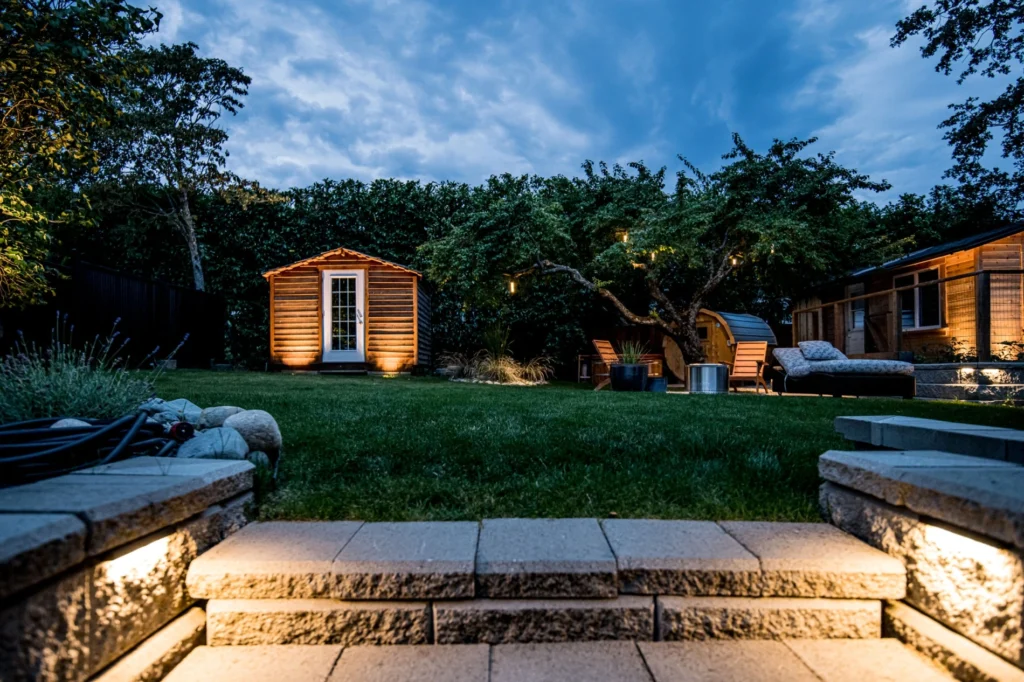Lighting up your outdoor space is a fantastic idea! Landscape lighting can add security, value, and beauty to your property while also creating more usable living space. But before you say yes, you’ll want an idea of what this kind of investment might look like. While the final cost of landscape lighting projects can vary widely, we’ll do our best to give you an idea of the different elements that can affect the final price.
Type of Property and Scope of Work
The type of property can play a big role in cost. A sprawling commercial property or oceanside estate can differ wildly from a small residential yard. Conversely, a new construction project may offer an easier and less expensive way of installing wiring than trenching through an existing property or running conduit underneath an existing driveway.
Jumps (or Breaks in Installation)
Jumps refer to breaks or gaps in the design, commonly resulting from architectural features like gables, dormers, or structural elements. Each jump necessitates additional wiring, connectors, and attention to detail to ensure a clean and professional finish. These extra steps add cost in both material and labour.
Design and Aesthetic Intentions
If you want to make your pathway safer to navigate at night, you will likely have more cost-effective options than if your goal is to add layering and depth, colour-changing features, etc.
For larger projects, engaging a designer can add value by creating a more cohesive and impactful outcome, but that value added will likely also come with an upfront cost.
Types of Fixtures Used
Landscape lighting comes in different levels—good, better, and best. There are plenty of options at lower price points, but we focus on products that offer lasting quality and performance. We’ll cover other choices in a future article to help you understand all the possibilities.
Integrated Fixtures (fixtures where the LED is built into the fixture) generally are more efficient, more durable, and longer-lasting than Drop-in Fixtures (fixtures with replaceable bulbs), but they also come with a higher upfront cost. Drop-in Fixtures have a lower initial cost and offer more flexibility to upgrade bulbs as technology improves; however, they typically incur higher maintenance costs over time.
Another consideration with fixtures is the type of material used to make the housing. On the lower end, you can find plastic and low-quality aluminum fixtures, but for higher quality, you’ll be upgrading to higher-end aluminum, stainless steel, copper, or brass. These higher-end options are more durable, stand up better to harsh weather conditions and maintain their aesthetic value for much longer.
Lighting Technology
There is a wide range of technology available to suit different needs, styles, and budgets. Entry-level systems often use basic low-voltage LED fixtures, which are cost-effective, energy-efficient, and ideal for functional pathways or garden lighting. Mid-range options include integrated LED fixtures with better optics, longer warranties, and improved weather resistance—perfect for lasting performance in Canadian climates. At the high end, you’ll find smart lighting systems with app or voice control, RGB colour-changing features, dimmable outputs, and programmable scenes, offering exceptional customization for entertainment or ambiance. Material quality, control systems, and installation complexity can all impact overall cost. By understanding the technology options, homeowners can make informed decisions that balance aesthetic goals, durability, and budget.
Installation Considerations
Every installation location will have its intricacies. Things like ground conditions (lush soil vs. rocky gravel), trenching needs, and hardscape surfaces can all affect what tools, equipment and labour will be needed.
Access to power can also be a big consideration, both for the location of the transformer as well as what gauge of wire will be necessary to ensure adequate voltage to the fixtures. (Simply put, the further the distance between the transformer and the fixture, the thicker the gauge of wire, the more expensive that wire is.)
Depending on the age of your home, you may also need to run a new dedicated power source to a usable location.
Labour Costs
Sometimes the labour on a project is very straightforward. A couple of folks spend a few hours at your home, setting up your transformer, installing the lights, testing the system and going home. Sometimes someone needs to return later on to do some Night Aiming (aiming downlights when it’s sunny out is not a very accurate way of doing it). Sometimes a sub-contracted arborist has to be engaged to hang a moonlight 60ft up in a tree. A pretty accurate estimate can be achieved through a good site walk, but it is almost impossible to guess at this cost before putting together the design.
Maintenance and Long-Term Costs
LED fixtures do require less frequent replacement, but regular maintenance is still an important aspect of upholding the value of your investment. We’ve seen many projects that had been installed years ago and never tended to again, and more often than not, the system is in a state of disarray. Wires have been cut, fixtures have been buried, there is an impressively large variety of insects living inside the transformer box, etc. Investing in a maintenance package that will clean your fixtures, rebury wires that have come up, check the line voltage, re-aim any lights that have been jostled, etc. is a great way to keep your system performing as it should.
It is also a great way to make sure that any time-sensitive warranty issues are attended to.
Budget Ranges and Realistic Expectations
As each of the previous points has suggested, costs vary greatly from project to project but some basic ballpark ideas to go on would look like this:
Basic System (4-6 fixtures): $2,500 – $3,500
Medium System (8-15 fixtures): $4,000 – $7,500
High-end System (20+ fixtures with zones and smart controls): $8,500 – $20,000+
Free Quote and Friendly Advice from Light Right
At Light Right, we offer complimentary, no-obligation quotes and are always happy to answer any questions about landscape lighting.
Our goal is to provide you with all the information you need to make the best decision for your home.




